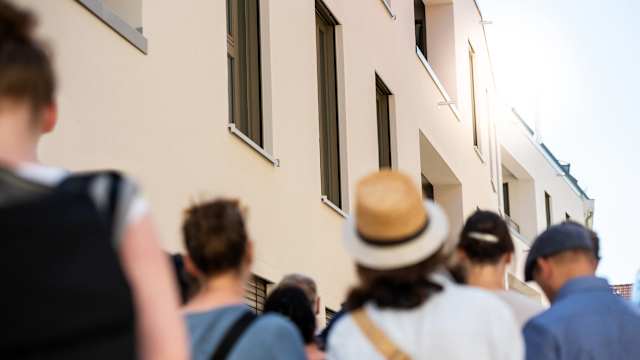Smart home and smart living – costs and features
Smart living makes life more convenient and secure. Comparis shows you how to set up a smart home, and how much it costs.

07.02.2024

iStock/RossHelen
1. What is a smart home?
A smart home consists of networked household appliances. These appliances can perform certain activities, such as:
Lamps turn on at a specified time or brightness.
The heating regulates the temperature automatically.
Your coffee machine switches itself on in the morning.
The list of examples for home automation is endless. You can set up a smart home system for all your needs. “Smart living” refers to living in a smart home.
2. How does smart living work?
Smart homes are fitted with sensors that detect changes in the environment. They can detect movement, identify open windows and check the position of the sun, for example. They transmit this data to a smart home control panel. The control panel then sends commands to the individual appliances and devices.
You usually manage your smart home control panel with a smartphone app. You can also use voice control as an alternative. To do this, you need speakers that are connected to voice assistants such as Alexa or Google Home.
Smart homes: wireless or cable network?
The different devices are connected to each other as well as to a central controller. Signals are transmitted either via a cable network or wirelessly via WiFi or Bluetooth.
Wireless systems: easier to install. You can also use wireless systems in a rented apartment.
Cable network: best suited for a new build. This is because experts have to lay the cables.
Important: smart home systems need a fast and stable internet connection.
3. What products are available for a smart home?
Practically all household appliances are now also available in a “smart” version – from vacuum cleaners to refrigerators. Perhaps convenience is especially important for you. Meanwhile, other people are mainly interested in security or want to save energy with a smart home.
An overview of the most common smart home products
Light control: colour of the light, automatic switching on and off
Heating control: automatically adjusts heat
Sunlight and shade: smart shutters and blinds
Entertainment: smart-TVs, home sound systems
Security: smart door locks, cameras, video intercoms via smartphone
Smart garden: irrigation systems, smart greenhouses
4. What are the benefits of a smart home?
Above all, home automation offers convenience in everyday life. In addition, smart living can increase security at home. Used correctly, it also improves energy efficiency.
One of the biggest advantages of smart homes is their convenience. Imagine: you’re on your way home from work on a hot summer’s day. As you arrive, the garage door opens automatically and the burglar alarm switches itself off. The heat sensors have already set off the lawn sprinkler. The living room is pleasantly cool thanks to intelligent air conditioning.
This is just one scenario that shows how much more convenient life can be in a smart home. The possibilities are virtually endless.
According to a study by the German Fraunhofer Institute, you can save 8% to 19% on energy in an automatically regulated household (link in German). This would cut a household’s annual electricity bill by several hundred francs.
Example: if a window is opened, the heating turns down automatically, or the controller puts the house in energy-saving mode when you go out. Since you control the energy consumption of each device, you can also easily identify devices using a lot of energy.
Security packages make it appear that residents are still at the property to keep burglars away. Glass-breakage sensors switch the light on or alert the police when they are activated. You can monitor certain areas remotely via camera.
In addition, your home is better protected against damage: water or fire damage can be minimized by smart home controls. Intelligent, networked smoke detectors send out an alarm by text message in the event of a fire. You can discover a burst pipe on your washing machine before your basement floods.
5. How safe are smart home systems?
In order for a smart home to work and learn, it stores personal data. This data reveals a lot about your preferences, daily routines and habits.
This is a good reason not to live in a smart home for some people. But you don’t have to be afraid. With the necessary security precautions, you can prevent hacker attacks.
Choose a reputable provider with transparent data protection who works with end-to-end encryption.
Ask the manufacturer of your smart home devices for their privacy policy.
Use systems that store data locally rather than in the cloud (if possible).
If you work with a voice assistant, you should specifically configure its privacy settings.
Use strong passwords that you change regularly – also for your WiFi and smartphone.
You can also use two-factor authentication.
Updating regularly makes it even harder for the system to be hacked.
6. Smart home costs: how much does smart living cost?
It’s difficult give a clear answer here. The costs depend on the system chosen and what it does. How many rooms would you like to fit with smart devices and with how many devices? The cost of the basic equipment is usually manageable, but it gets more expensive with accessories and extensions.
Starter packages are available for as little as 200 francs, while a smart thermostat costs around 50 francs. Motion detectors, dimmers and smart lights are also in this price range. Complete solutions with a cable network are more costly. Here you should expect to pay several thousand francs.
7. Can I set up my smart home myself?
Do you want a closed system with a cable network? Then you need support from specialists.
You can set up wireless systems that work with WiFi, radio or via the mains yourself. They are also better suited for a smart home rental apartment.
There are usually “plug-and-play” solutions available: simply plug the products into the power supply or put batteries in the sensors. You complete set up via the app.
If the changes can be undone when you move out, smart living in a rented apartment is no problem. You can always set up smart lighting or a home sound system in your rental apartment.
However, if you make any changes to the building structure, be sure to contact the landlord first.
Think about what your smart home should be able to do and how much money you want to spend. Make sure that the products are compatible with different manufacturers. This will allow you to expand your smart home later.
Start planning your layout: which smart devices would you like and in which rooms? Start small with some smart power outlets, lamps or a smart thermostat. Gradually you can upgrade your apartment.
This article was first published on 05.02.2018


